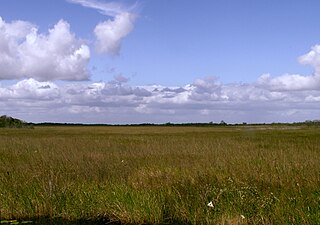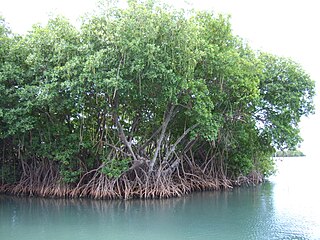
The Everglades is a natural region of flooded grasslands in the southern portion of the U.S. state of Florida, comprising the southern half of a large drainage basin within the Neotropical realm. The system begins near Orlando with the Kissimmee River, which discharges into the vast but shallow Lake Okeechobee. Water leaving the lake in the wet season forms a slow-moving river 60 miles (97 km) wide and over 100 miles (160 km) long, flowing southward across a limestone shelf to Florida Bay at the southern end of the state. The Everglades experiences a wide range of weather patterns, from frequent flooding in the wet season to drought in the dry season. Throughout the 20th century, the Everglades suffered significant loss of habitat and environmental degradation.

The New Jersey Department of Environmental Protection (NJDEP) is a government agency in the U.S. state of New Jersey that is responsible for managing the state's natural resources and addressing issues related to pollution. NJDEP now has a staff of approximately 2,850.

The New York State Department of Environmental Conservation is a department of New York state government. The department guides and regulates the conservation, improvement, and protection of New York's natural resources; manages Forest Preserve lands in the Adirondack and Catskill parks, state forest lands, and wildlife management areas; regulates sport fishing, hunting and trapping; and enforces the state's environmental laws and regulations. Its regulations are compiled in Title 6 of the New York Codes, Rules and Regulations. It was founded in 1970, replacing the Conservation Department, and is headed by Basil Seggos.

The Massachusetts Department of Environmental Protection is an agency in the Executive Office of Energy and Environmental Affairs of the Commonwealth of Massachusetts, responsible for protecting the environment in the state. Its areas of responsibility include preventing pollution of air, water, and ground; protecting wetlands; waste and recycling issues; regulating hazardous materials; and reducing climate change.
The Pennsylvania Department of Conservation and Natural Resources (DCNR), established in 1995, is the agency in the U.S. state of Pennsylvania responsible for maintaining and preserving the state's 124 state parks and 20 state forests; providing information on the state's natural resources; and working with communities to benefit local recreation and natural areas. The agency has its headquarters in the Rachel Carson State Office Building in Harrisburg.

The Ministry of Ecology and Environment is an executive-department of the State Council of the People's Republic of China, responsible for the ecological and environmental affairs. It is the 15th-ranked department in the State Council.

The New York City Department of Environmental Protection Police, also known as DEP Police, and formerly known as the Bureau of Water Supply Police and the Aqueduct Police, is a law enforcement agency in New York City whose duties are to protect and preserve the New York City water supply system maintained by the New York City Department of Environmental Protection, the nation's largest single source water supply. The department has protected and preserved the water supply system for over 100 years.
The Pennsylvania Department of Environmental Protection (DEP) is the agency in the U.S. state of Pennsylvania responsible for protecting and preserving the land, air, water, and public health through enforcement of the state's environmental laws. It was created by Act 18 of 1995, which split the Department of Environmental Resources into the Department of Environmental Protection and the Department of Conservation and Natural Resources. Its current secretary is Jess Shirley.

The Florida Fish and Wildlife Conservation Commission (FWC) is a Florida government agency founded in 1999 and headquartered in Tallahassee. It manages and regulates the state's fish and wildlife resources, and enforces related laws. Officers are managers, researchers, and support personnel, and perform law enforcement in the course of their duties.

The environment of Florida in the United States yields an array of land and marine life in a mild subtropical climate. This environment has drawn millions of people to settle in the once rural state over the last hundred years. Florida's population increases by about 1,000 residents each day. Land development and water use have transformed the state, primarily through drainage and infill of the wetlands that once covered most of the peninsula.

The California Environmental Protection Agency, or CalEPA, is a state cabinet-level agency within the government of California. The mission of CalEPA is to restore, protect and enhance the environment, to ensure public health, environmental quality and economic vitality.

A conservation officer is a law enforcement officer who protects wildlife and the environment. A conservation officer may also be referred to as an environmental technician/technologist, game warden, park ranger, forest watcher, forest guard, forester, gamekeeper, investigator, wildernessofficer, wildlifeofficer, or wildlife trooper.

An ongoing effort to remedy damage inflicted during the 20th century on the Everglades, a region of tropical wetlands in southern Florida, is the most expensive and comprehensive environmental repair attempt in history. The degradation of the Everglades became an issue in the United States in the early 1970s after a proposal to construct an airport in the Big Cypress Swamp. Studies indicated the airport would have destroyed the ecosystem in South Florida and Everglades National Park. After decades of destructive practices, both state and federal agencies are looking for ways to balance the needs of the natural environment in South Florida with urban and agricultural centers that have recently and rapidly grown in and near the Everglades.

Mangrove ecosystems represent natural capital capable of producing a wide range of goods and services for coastal environments and communities and society as a whole. Some of these outputs, such as timber, are freely exchanged in formal markets. Value is determined in these markets through exchange and quantified in terms of price. Mangroves are important for aquatic life and home for many species of fish.
The Everglades Forever Act is a Florida law passed in 1994 designed to restore the Everglades. The law recognized, the “Everglades ecological system is endangered as a result of adverse changes in water quality, and in the quantity, distribution and timing of flows, and, therefore, must be restored and protected.” The law was codified in § 373.4592, Florida Statutes. The law was amended twice in 2003.
Friends of the Everglades is a conservationist and activist organization in the United States whose mission is to "preserve, protect, and restore the only Everglades in the world." The book Biosphere 2000: Protecting Our Global Environment refers to Friends of the Everglades as an organization that has fought to preserve North America's only subtropical wetland.

Florida has two Level I and three Level II/III ecoregions containing more than 80 distinct ecosystems. From the northwestern panhandle to the Everglades, differences in hydrology, climate, landforms, soil types, flora, and fauna shape each ecosystem, creating a complex landscape that has been recognized as a global biodiversity hotspot.














